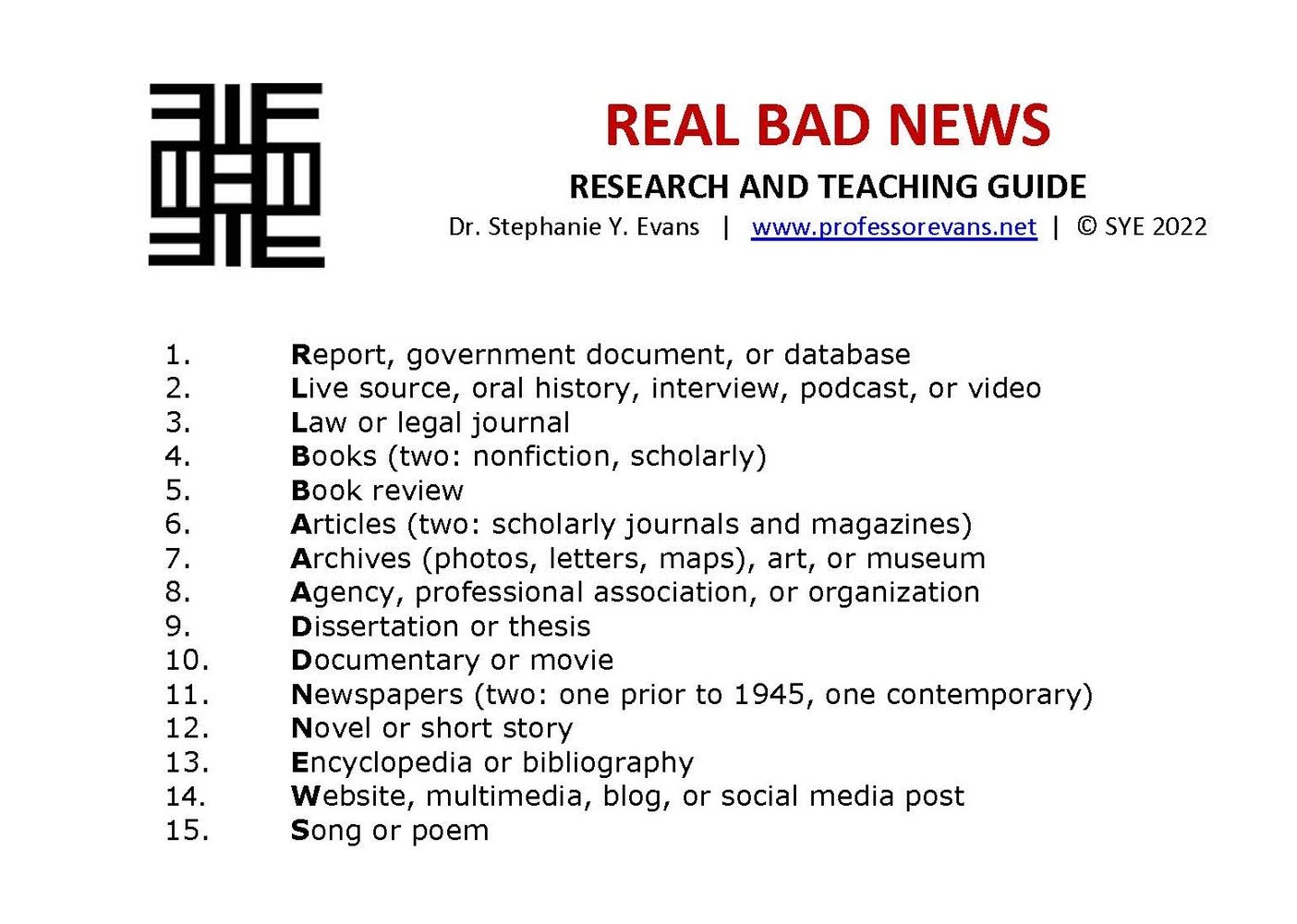
A TOOL FOR LEARNING WITH MULTIPLE SOURCE TYPES
"SCHOLARS WITHOUT SOURCES
ARE REAL BAD NEWS"

"SCHOLARS WITHOUT SOURCES
ARE REAL BAD NEWS"

“Give a man a fish and he’ll eat for a day. Teach him how to fish and he’ll eat forever.”
~African Proverb
“Give students a source, and they’ll read for a day. Teach them how to find sources and they’ll read forever.”
~Stephanie Y. Evans
This website offers a teaching tool for a 16-week semester, but can be adapted for shorter periods as well. The focus on sources offers an alternative to chronology or theme as a syllabus structure. You can also use "book clubs" as a way to assign multiple texts in the class.
When I began as a professor in 2003, I created the REAL BAD NEWS tool for my research courses. I require at least 10 different source types for final papers in all of my classes (graduate and undergraduate). This detailed list of required primary, secondary, and tertiary sources for research papers guides students to sources for synthesis and analysis.
I have long lived by the African adage about teaching research skills rather than simply providing information. By exploring fifteen different source types throughout the semester, I am teaching the skill of information literacy. In early stages of my classes, it was a struggle not to overwhelm students with the idea of locating a diversity of sources. But now, by tackling ONE SOURCE TYPE PER WEEK, this can be a bit less intimidating for students, and allow more in-depth understanding throughout the semester.
Regardless of the course topic, my classes are research focused where I introduce a diversity of source types relevant to themes discussed in class. Students read the assigned source, but also locate sources based on their own research interest. Students create several short papers and the final paper from a mix of assigned readings and sources they choose. Final paper topics highlight the course themes in a way that informs their own personal, intellectual, and professional interests.
Scholars without sources are REAL BAD NEWS.
I hope this website helps you develop as a thinker, researcher, and writer--whether you are enrolled in my class or not. When you learn the art of finding and synthesizing sources, you deepen your understanding of a topic, identify the nuances that defy easy answers, and learn how to say something "new" because you've taken the time to weigh a wide range of existing evidence. These sources can help you in your literature review (secondary and tertiary sources), as well as identifying potential data sets for original research (primary sources). When writing your research papers, keep in mind some evaluation criteria below. Learn how to edit and evaluate your own work (and that of your peers). Warm wishes for your success!
· CONTENT: Main idea; relevant question; engage sources to answer question; thesis statement; theoretical frame; methodology; argument development; relevant evidence; provides detailed points about time, place, and context; give point of view and acknowledge author’s standpoint; style; originality; engages Bloom’s taxonomy (KCAASE); addresses research ethics and impact on human rights.
· STRUCTURE: Organized with unified beginning, middle, and end; clear flow of ideas; effective use of sections and subsections; transitions; paragraphs and sentence structure; proper punctuation; level-appropriate language; mechanics; evidence of editing.
· SOURCES: Valid sources that support but also complicate argument; appropriate scholarly review; primary documents with nuanced interpretation; correct citation in text and bibliography; correct citation for academic discipline: Chicago, MLA, or APA.
We use cookies to analyze website traffic and optimize your website experience. By accepting our use of cookies, your data will be aggregated with all other user data.